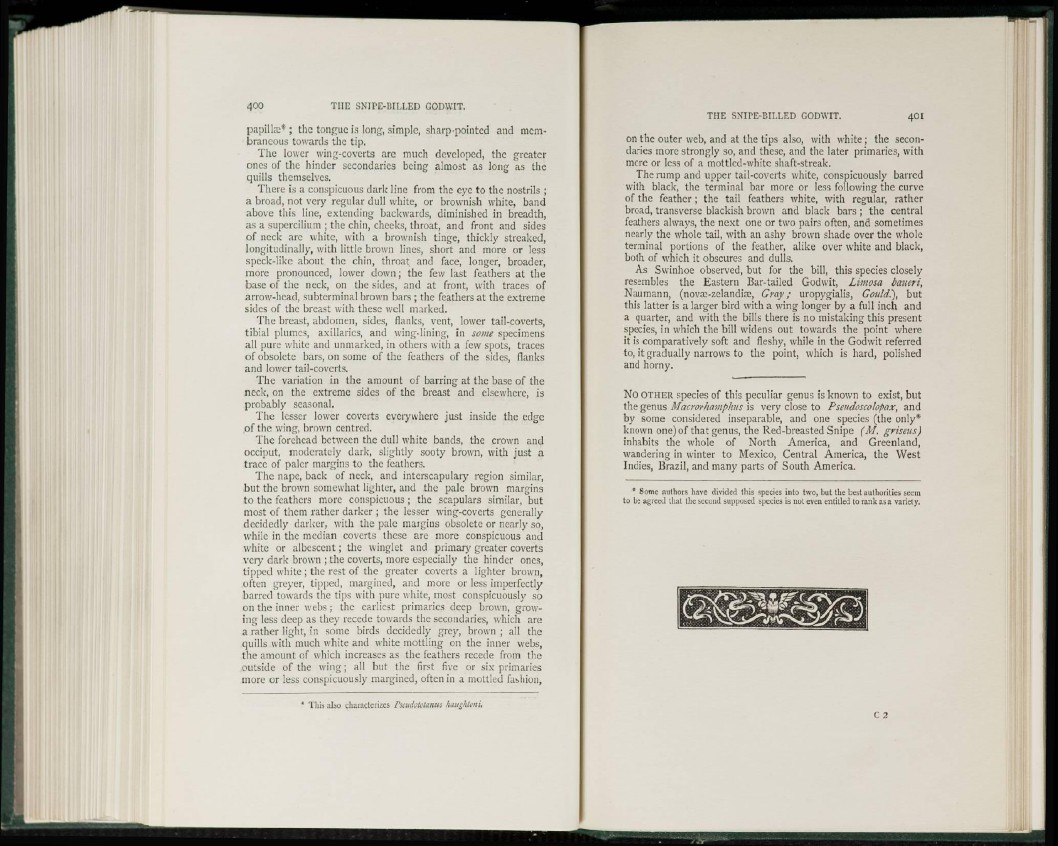
papillae*!1; the tongue is long, simple, sharp-pointed and membraneous
towards the tip.
The lower wing-coverts are much developed, the greater
ones of the hinder secondaries being almost as long as the
quills themselves.
There is a conspicuous dark line from the eye to the nostrils ;
a broad, not very regular dull white, or brownish white, band
above this line, extending backwards, diminished in breadth,
as a supercilium ; the chin, cheeks, throat, and front and sides
of neck are white, with a brownish tinge, thickly streaked,
longitudinally, with little brown lines, short and more or less
speck-like about the chin, throat and face, longer, broader,
more pronounced, lower down; the few last feathers at the
base of the neck, on the sides, and at front, with traces of
arrow-head, subtcrminal brown bars ; the feathers at the extreme
sides of the breast with these well marked.
The breast, abdomen, sides, flanks, vent, lower tail-coverts,
tibial plumes, axillarics, and wing-lining, in some specimens
all pure white and unmarked, in others with a few spots, traces
of obsolete bars, on some of the feathers of the sides, flanks
and lower tail-coverts.
The variation in the amount of barring at the base of the
neck', on the extreme sides of the breast and elsewhere, is
probably seasonal.
The lesser lower coverts everywhere just inside the edge
of the wing, brown centred.
The forehead between the dull white bands, the crown and
occiput, moderately dark, slightly sooty brown, with just a
trace of paler margins to the feathers.
The nape, back of neck, and interscapulary region similar,
but the brown somewhat lighter, and the pale brown margins
to the feathers more conspicuous ; the scapulars similar, but
most of them rather darker ; the lesser wing-coverts generally
decidedly darker, with the pale margins obsolete or nearly so,
while in the median coverts these are more conspicuous and
white or albescent; the winglet and primary greater coverts
very dark brown ; the coverts, more especially the hinder ones,
tipped white ; the rest of the greater coverts a lighter brown,
often greyer, tipped, margined, and more or less imperfectly
barred towards the tips with pure white, most conspicuously so
on the inner webs ; the earliest primaries deep brown, growing
less deep as they recede towards the secondaries, which are
a rather light, in some birds decidedly grey, brown ; all the
quills with much white and white mottling on the inner webs,
the amount of which increases as the feathers recede from the
outside of the wing; all but the first five or six primaries
more or less conspicuously margined, often in a mottled fashion,
* This also characterizes rscudeLHanus haughlmi.
on the outer web, and at the tips also, with white ; the secondaries
more strongly so, and these, and the later primaries, with
more or less of a mottled-white shaft-streak.
The rump and upper tail-coverts white, conspicuously barred
with black, the terminal bar more or less following the curve
of the feather ; the tail feathers white, with regular, rather
broad, transverse blackish brown and black bars ; the central
feathers always, the next one or two pairs often, and sometimes
nearly the whole tail, with an ashy brown shade over the whole
terminal portions of the feather, alike over white and black,
both of which it obscures and dulls.
As Swinhoe observed, but for the bill, this species closely
resembles the Eastern Bar-tailed Godwit, Limosa bciueri,
Naumann, (novre-zelandias, Gray; uropygialis, Gould.), but
this latter is a larger bird with a wing longer by a full inch and
a quarter, and with the bills there is no mistaking this present
species, in which the bill widens out towards the point where
it is comparatively soft and fleshy, while in the Godwit referred
to, it gradually narrows to the point, which is hard, polished
and horny.
No OTHER species of this peculiar genus is known to exist, but
the genus Macrorhampkus is very close to Psendoscolopax, and
by some considered inseparable, and one species (the only*
known one)of that genus, the Red-breasted Snipe (M. griseus)
inhabits the whole of North America, and Greenland,
wandering in winter to Mexico, Central America, the West
Indies, Brazil, and many parts of South America.
* 8OME authors have divided this species into two, hut the hest authorities seem
to be agreed that the second supposed species is not even entitled to rank as a variety.
C 2